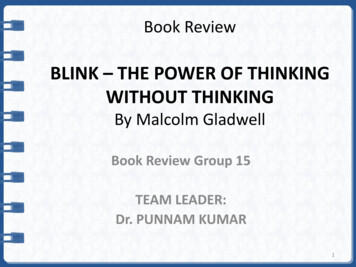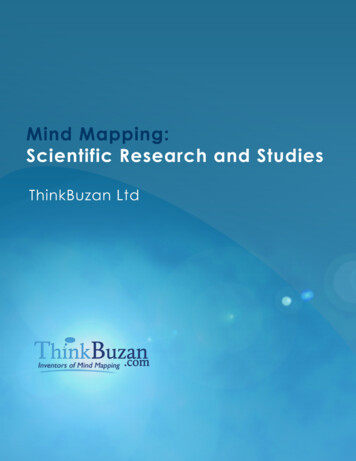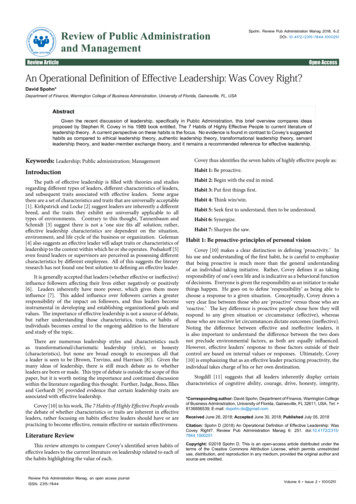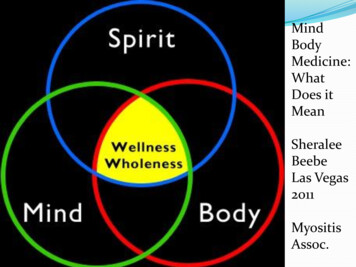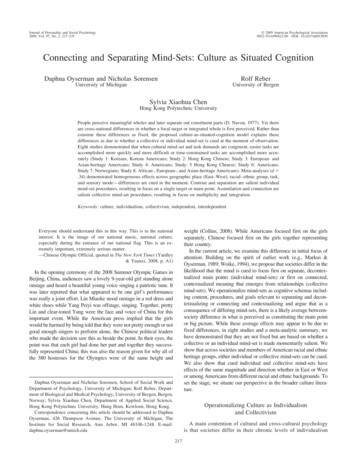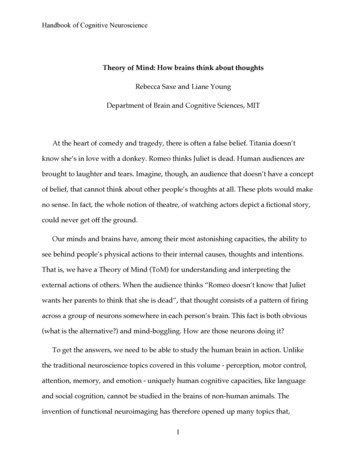
Transcription
Handbook of Cognitive NeuroscienceTheory of Mind: How brains think about thoughtsRebecca Saxe and Liane YoungDepartment of Brain and Cognitive Sciences, MITAt the heart of comedy and tragedy, there is often a false belief. Titania doesn’tknow she’s in love with a donkey. Romeo thinks Juliet is dead. Human audiences arebrought to laughter and tears. Imagine, though, an audience that doesn’t have a conceptof belief, that cannot think about other people’s thoughts at all. These plots would makeno sense. In fact, the whole notion of theatre, of watching actors depict a fictional story,could never get off the ground.Our minds and brains have, among their most astonishing capacities, the ability tosee behind people’s physical actions to their internal causes, thoughts and intentions.That is, we have a Theory of Mind (ToM) for understanding and interpreting theexternal actions of others. When the audience thinks “Romeo doesn’t know that Julietwants her parents to think that she is dead”, that thought consists of a pattern of firingacross a group of neurons somewhere in each person’s brain. This fact is both obvious(what is the alternative?) and mind-boggling. How are those neurons doing it?To get the answers, we need to be able to study the human brain in action. Unlikethe traditional neuroscience topics covered in this volume - perception, motor control,attention, memory, and emotion - uniquely human cognitive capacities, like languageand social cognition, cannot be studied in the brains of non-human animals. Theinvention of functional neuroimaging has therefore opened up many topics that,1
Handbook of Cognitive Neurosciencehistorically, belonged only to social sciences: how we think about people, how we thinkabout thoughts, how we make moral judgments, and more.Although the neuroscience of ToM is only around a decade old, we will reviewevidence that begins to address some fundamental questions. What are the neuralsubstrates of ToM? Are there distinct brain regions selectively recruited for ToM (asthere are regions for vision, audition, motor control, etc.)? If so, what are (and aren’t)these brain regions doing? Are there distinct cognitive components of ToM? Answersto these questions provide the foundation for a cognitive neuroscience of Theory ofMind.Where in the brain do people think about thoughts?Human adults can think about other people as having an infinite array of beliefs anddesires, ranging from trivial to sublime, from familiar to exotic, from simple toremarkably complex.For example, consider the following story: Sally and Anne go to the same highschool. Sally doesn’t suspect that Anne knows that Sally’s boyfriend Tom believes thatthe tooth fairy stole the quarterback’s lucky tooth before the big game, jinxing the team.Anne also knows that Tom will propose to Sally at graduation, so Anne realises thatonly she can stop their engagement.Even though this story is highly complex, the people are unfamiliar to you, and youlikely have never considered the possibility of the tooth fairy’s interference in a footballgame, you can nevertheless make sense of this story, and predict and explain thecharacters’ actions and emotions. How do you do it? What is happening in your brain2
Handbook of Cognitive Neurosciencewhile you read the story? Let’s imagine following the story from the pattern on thepage to the pattern in your brain.First, the pattern of light and dark on the page reaches your eyes, and then yourvisual cortex. Here the brain begins to recognise shapes, and to test hypotheses aboutwhich letters and words are on the page. Soon, language brain regions are involved,helping to transform the representations from orthographic symbols to words andsentences that describe objects, events, and ideas - these representations are complex.As you build up a mental representation of all the elements in the story, your workingmemory helps to hold and manipulate the elements, while executive control supportsshifts between the competing components of the event. In particular, executive controlhelps you keep track of what really happened, distinct from what Sally didn’t suspectthat Anne knew that Tom believed was happening. As you begin to understand andrepresent the events of the story, specific aspects of the story become clear. This is astory about people, social relationships, and human actions. This story requires you tothink about different perspectives or representations of the same facts; that is, it requiresthe capacity to form “meta-representations”. And this story requires you to think aboutpeople’s thoughts, beliefs, desires, motivations, and emotions.Remarkably, human cognitive neuroscience can already help us pinpoint where inthe brain each one of these different cognitive processes is occurring. Other chapters ofthis handbook describe the brain regions and processes involved in vision, wordrecognition, language comprehension, working memory, and executive function. Mostinteresting for our current purposes are three cognitive processes (and associated brainregions) that appear to be disproportionately necessary for reading and understandinga story about people and what they are thinking: (a) representing people and social3
Handbook of Cognitive Neurosciencerelations (e.g., dorsal medial prefrontal cortex); (b) representing representations (e.g.,left temporo-parietal junction); and (c) representing mental representations (e.g. righttemporo-parietal junction), that is, thinking about thoughts.All of these brain regions had a high metabolic response while you were reading thestory about Sally, Anne and Tom, but for different reasons - these brain regions performdifferent functions in helping you to perceive and reason about the story. Tounderstand how we infer these different functions, it’s helpful to imagine an(implausible) meta-experiment, in which we could present participants with 5 differentkinds of stimuli and see which patterns of responses we observe, and where. Each brainregion or system would reveal different patterns of functional response across thecategories (see Figure 1 for a schematic representation of the imaginary experiment, andFigure 2 for sample stimuli from actual experiments).For example, there is a region near the calcarine sulcus that responds robustly whenpeople read stories and look at pictures but not when people listen to stories or tomusic. Meanwhile, there is no difference in this region’s response to the specific contentof the stories, i.e. whether the stories focus on physical objects, temporal changes,people, or their thoughts. However, the response in this brain region to the same storyis very different depending on whether the story is presented visually (a high response)or aurally (a low response). Correspondingly, people with damage near the calcarinesulcus cannot perceive visually presented pictures or sentences but have no troubleunderstanding aural language or thinking about thoughts. Based on this pattern, wecan diagnose that the cortex near the calcarine sulcus contains a brain region that isinvolved in visual perception (ref to vision chapter). This, of course, would not be news.4
Handbook of Cognitive NeuroscienceThe visual system is one of the best-understood parts of the brain; none of the otherbrain regions we will consider here is affected by the modality of the stimulus.Relying on a similar logic, we can look for patterns of functional responses andselective deficits, to infer the cognitive functions of other less well-understood brainregions, and also to learn about how these cognitive functions are related in the brain.For example, there is a brain region in the left dorsolateral prefrontal cortex (leftDLPFC) that shows a high response for stimuli requiring difficult reasoning, especiallyfor balancing competing ideas or responses. This brain region shows a high responsewhen people read a story that describes two competing versions of reality: one past andone present, or one in a photograph and one in reality, or one that someone believesand one that actually happened. This brain region also shows a high response whenyou try to name the red ink colour of the word “green”, compared to the blue ink colourof the word “blue” - the standard Stroop task manipulation of conflict (MacDonald,Cohen, Stenger, & Carter, 2000). Damage to this brain region therefore makes it difficultto resolve such cognitive competition, and as a result can make it difficult for people toreason accurately about another person’s thoughts and beliefs in certain cases. Forexample, patients with left DLPFC damage wouldn’t be able to balance their own ideasabout Tom and the competing ideas about Tom held by Anne and Sally. Instead, thesepatients would just stick with their own perspective: if Tom is crazy, then Sally won’twant to marry him. On the other hand, if there is no conflict in the story - for example,when we hear that Anne thinks only she can stop the engagement, which might be trueor false and doesn’t conflict with any other ideas - these patients have no problemsthinking about beliefs per se, and predicting what Anne will do next (Apperly, Samson,Chiavarino, & Humphreys, 2004).5
Handbook of Cognitive NeuroscienceA brain region in the left temporo-parietal junction (TPJ) shows a second functionalprofile. The left TPJ response is high for any story, picture, or task that requiresreasoning about perspectives, or representations of the world - whether thoserepresentations are mental representations (like people’s beliefs about the world), orphysical representations (like photographs of the world). Correspondingly, patientswith damage to the left TPJ have difficult with tasks that require reasoning aboutbeliefs, photographs and maps, but not with other ‘high-conflict’ tasks, like naming theink colour of the word “green”, printed in red ink. These patients have trouble thinkingabout any kind of belief or indeed any representation at all, including a physicalrepresentation like a photograph, whether or not these representations conflict withreality. So we can infer that the left TPJ is involved in meta-representation, includingbut not limited to representing mental representations.The functions of the DLPFC and the LTPJ may seem similar, but they have beenelegantly dissociated by Dana Samson, Ian Apperly and colleagues, in studies ofpatients with selective lesions. To get a sense for the dissociation, imagine the storycontinues on, to reveal who actually stole the lucky tooth: a crazy ex-girlfriend of thequarterback. Now, if you must answer, “what does Tom think happened to the quarterback’s tooth?”, you might consider three possible answers. First, the correct answer,which depends on keeping track of Tom’s false belief, would be “he thinks the toothfairy stole it.” Second, if you couldn’t hold on to Tom’s belief in the face of the strongercompetition from your knowledge of what really happened, then the ‘reality-error’answer would be “he thinks an ex-girlfriend stole it”. This is the kind of error producedby DLPFC damage. Third, though, if you could resist competition from reality, butcouldn’t hold on to a representation of Tom’s belief, then you might just seek a likely6
Handbook of Cognitive Neuroscienceexplanation for a quarterback’s missing tooth, and make the ‘appearance-error’: “hethinks it was knocked out during a game.” Left TPJ damage, but not DLFC damage,leads to ‘appearance’ errors (Samson, Apperly, Chiavarino, & Humphreys, 2004).In sum, thinking about thoughts depends on many cognitive functions that are notspecific to ToM. ToM tasks are often hard logical problems, involving complexreasoning and perspective shifts, and therefore rely on multiple brain such regions DLPFC and LTPJ are only examples. In addition, though, human cognitive neurosciencehas revealed another group of brain regions, with a notably different pattern ofresponse: these regions are involved specifically in thinking about other people.Returning to our imaginary experiment, a third functional profile can be found in athe medial prefrontal cortex (MPFC)1. Here we would not see a high response to storiesabout photographs, or physical interactions, or temporal changes; only stories withpeople and social relationships elicit a response in the MPFC. Thus, we can infer thatthe MPFC is involved specifically in social cognition.Finally, a brain region near the right temporo-parietal junction (RTPJ) shows arobust response during our original story (regardless of modality), but does notrespond to any of the other conditions in this imaginary experiment - not to difficultlogical problems, or stories about photographs, or stories about people and socialrelationships (R. Saxe & Kanwisher, 2003; R. Saxe & Powell, 2006 ). Of the conditions inour imaginary experiment, the RTPJ region shows a high response only when the storydescribes someone’s thoughts and beliefs.1Here, we describe the MPFC as a single region, though research has shown dissociable sub-regionswithin the MPFC, including the ventral MPFC and the dorsal MPFC. In some cases, these sub-regionshave importantly different response profiles (Mitchell, Macrae, & Banaji, 2006). Here we try to focus onfeatures of the response that are common across sub-divisions of the MPFC, for simplicity, but westrongly urge readers specifically interested in the MPFC to consider these differences, as described inother reviews (e.g. (Adolphs, 2009)).7
Handbook of Cognitive NeuroscienceRegions in MPFC and RTPJ are most commonly recruited together, possibly becausethinking about thoughts usually also involves thinking about people and socialrelationships (broadly construed; see Figure 2). However, careful experiments revealfascinating functional dissociations between these two regions. For example, activity inyour RTPJ was high when you read about Sally, Anne and Tom’s true and false beliefs,but would be low if you were reading instead about what Sally looks like (i.e. herphysical traits) and whether she is stubborn or lazy (i.e. her personality traits), whereAnne comes from and how many siblings she has (i.e. her history and status), or whatTom prefers to eat for breakfast (i.e. his stable preferences). Even reading about howSally feels when she’s hungry or tired or in physical pain would not elicit a robustresponse in the RTPJ (Bedny, Pascual-Leone, Dodell-Feder, Fedorenko, & Saxe; Jenkins& Mitchell, 2009; R. Saxe & Powell, 2006 ; R. R. Saxe, Whitfield-Gabrieli, Scholz, &Pelphrey, 2009). Regions in the MPFC, on the other hand, would show high activity formost of this information, especially descriptions of stable preferences and personalitytraits (Jenkins & Mitchell, 2009). One factor that matters to the response in MPFC, butnot in RTPJ, is the person being described. The response in the MPFC region would bemuch higher if Sally, Anne and Tom were friends of yours - either people you foundsimilar to yourself, or people who were emotionally close to you (Krienen, Tu, &Buckner; Mitchell, et al., 2006). By contrast, the RTPJ does not seem to care about theidentity of the target.What happens when these regions, the MPFC and the RTPJ, are not functioningproperly? Damage to MPFC often leads to problems, for example, for thinking aboutother people’s emotions (Shamay-Tsoory, Tomer, Berger, & Aharon-Peretz, 2003), butnot necessarily for thinking about people’s thoughts (Bird, Castelli, Malik, Frith, &8
Handbook of Cognitive NeuroscienceHusain, 2004). Selective damage to the RTPJ has not been as well studied, but similarevidence comes from an experiment in which we can produce a temporary or reversible‘lesion’, using a tool called transcranial magnetic stimulation (TMS). To understand theexperiment, it will help to start with a new story about Sally and Anne.Imagine Sally is making dinner for Anne. Based on something Anne said, Sallybelieves that Anne is violently allergic to peanuts. Sally grinds up some peanuts, andmixes them into the soup, which she then serves to Anne. In fact, Anne is allergic tococonuts but not peanuts, so she happily enjoys the soup. Now, did Sally do anythingmorally wrong? From the outside, nothing bad happened. Sally served Anne somedelicious soup. Most people, though, say that what Sally did was very wrong, becauseSally believed she was doing something wrong. The opposite case presents an evenstarker contrast. Imagine Sally adds coconut shavings to the soup, but she hasabsolutely no idea that Anne is allergic to coconuts or anything else. Now, Anne eatsthe soup and becomes fatally ill. Did Sally do anything morally wrong? In spite of thetragic consequences of her actions, most people say that what Sally did was not verywrong - because she reasonably believed her actions would not hurt anyone. Thesescenarios provide a sensitive measure of how much people are thinking about thoughts.The more you think about thoughts, the more you will blame Sally for attempting (butfailing) to poison Anne, and the more you will forgive her for accidentally makingAnne sick (and the more active your RTPJ will be! (Young & Saxe, 2009)).To test the role of the RTPJ in thinking about thoughts, we briefly disrupted normalneural function specifically in the RTPJ, using fMRI-guided TMS. When the RTPJ hasbeen targeted with TMS, moral judgments shift. Innocent accidents appear moreblameworthy, while failed attempts appear less blameworthy, as though it matters less9
Handbook of Cognitive Neurosciencewhat Sally believed she was doing, and it matters more what she actually does (Young,Camprodon, Hauser, Pascual-Leone, & Saxe, 2010). (People don’t lose the ability tomake moral judgments altogether; they still say it’s completely morally wrong tointentionally kill, and not wrong at all to simply serve someone soup). These results fitvery nicely with the fMRI studies. Activity in the RTPJ is correlated across time, acrosspeople, and across individual stories, specifically with the need to think about thoughts(Young & Saxe, 2008, 2009; Bruneau & Saxe, unpublished data), when function in theRTPJ is disrupted, people think less about thoughts and more about other features ofthe stories.Understanding the neural basis of theory of mind will therefore probably begin withunderstanding the function(s) of these regions, that is, the MPFC, for thinking aboutpeople, and the RTPJ, for thinking about thoughts, along with the interactions betweenthese regions with each another and with the rest of the brain. Provisionally, though,there seem to be patches of cortex in the human brain whose functions are specificallyrelated to ToM (RTPJ) or social cognition (MPFC). This claim raises key questions thatwe address in the next section: What does it mean to say that a brain region’s function is‘specifically related to ToM’? What are and aren’t these brain regions doing?How does the brain think about thoughts?From a certain perspective, ToM is a miracle. After all, thoughts are invisible: no onehas ever had any direct evidence of another person’s mental experience. How do ourbrains cross the gulf between our minds? One idea that may demystify the leap is thatwe understand other minds by “simulation” (Goldman, 2006). The central idea ofsimulation is that we understand other people because they are similar to us: theyexecute similar movements, and experience similar sensations, and make similar10
Handbook of Cognitive Neurosciencedecisions, using a body and mind similar to our own. As a result, we could use our ownmind (and body) as an analogue for another person’s mind. We could recreate inourselves a copy of their actions and sensations, and recapitulate our own experiencesin order to understand theirs. Could this be the distinctive function of ToM brainregions: to construct appropriate and useful simulations of other minds?People do seem to simulate the actions they observe, by activating matching motorrepresentations in their own brain and body. When a person watches someone else act,the observer can’t help but activate the same muscles and motor plans for that action(Fadiga, Craighero, & Olivier, 2005). As a result, action observation interferes withaction execution, and action execution interferes with action observation (Zwickel,Grosjean, & Prinz, 2010a, 2010b). Even when the other person’s actions are invisible,simply knowing about someone else’s incompatible action can cause interference. In anelegant series of studies, Saebanz and colleagues showed that interference fromthinking about another person’s actions is comparable to competition from one’s ownactions (Sebanz, Knoblich, & Prinz, 2003). That is, if you are trying to push the leftbutton, but thinking about pushing the right button, these two motor plans interferewith each other and slow you down. Amazingly, thinking about someone else’s actionhas the same effect: when you know someone else is supposed to push the right button,you yourself are slower to push the left button! A similar pattern occurs when youobserve what other people see. Seeing that another person sees more or less than you docan actually impair your ability to report what you yourself are seeing, as though youautomatically compute the other person’s view, which then competes with your ownview for verbal report (Samson, Apperly, Braithwaite, Andrews, & Scott, 2010). These11
Handbook of Cognitive Neuroscienceresults show that watching and understanding another person’s action compete for thesame cognitive and neural resources as executing one’s own action.Neural evidence converges on the same simulation story. Activity in the parietalcortex while watching someone else perform a simple hand action is suppressed if theparticipant had just previously made the same hand action, suggesting that therepresentation of one’s own action can be partially ‘recycled’ during observation ofsomeone else’s (Chong, Cunnington, Williams, Kanwisher, & Mattingley, 2008). And,complementarily, watching someone else’s hand movements leads to sub-thresholdpreparatory activity in one’s own motor cortex and hand muscles: this activity can beseen if it is artificially pushed over the threshold by a pulse of transcranial magneticstimulation (Sturmer, Siggelkow, Dengler, & Leuthold, 2000). Furthermore, theseactivations seem to be modulated by experience: the more experience the observer hashad actually performing a particular action, the more his or her motor cortex isactivated while observing others performing the same action. In one elegant example,the motor cortex of ballet dancers showed more activity when dancers observedgender-specific movements that they themselves had more experience executing(Calvo-Merino, Glaser, Grezes, Passingham, & Haggard, 2005; Cross, Hamilton, &Grafton, 2006), but equal experience observing, in dancers of both genders.A similar pattern holds for observing physical sensations in another person,especially physical pain. A common group of brain regions are recruited when peoplefeel their own pain, and when they see someone else in pain. Experiencing pain leads tobrain activity in the “pain matrix”, including regions in cingulate cortex, secondarysensory cortex, and bilateral insula. When observers witness other people in physicalpain, some of the same brain regions are activated (Botvinick, et al., 2005; Jackson,12
Handbook of Cognitive NeuroscienceRainville, & Decety, 2006; Singer & Lamm, 2009; Singer, et al., 2004). Activity in some ofthese regions is correlated with the intensity of pain, either experienced (Peyron,Laurent, & Garcia-Larrea, 2000) or attributed (Saarela, et al., 2007).In sum, we appear to ‘simulate’ other people’s actions and experience: as observers,we recruit (some of) the same representations as the target. Simulations - the re-cyclingof similar representations between first-person experience and third-person attributions- thus seem to reflect a general principle of how we bridge the gap between twoseparate human minds. Is activity in the RTPJ and MPFC also modulated by whetherthe mental states we attribute to other people are similar to mental states we’veexperienced in the first person? Similar to the logic of ‘simulation’ for actions andexperiences, do we understand someone else’s desire to become a neurosurgeon, orbelief that the Red Sox will win the World Series, by activating the same representationsin our own mind as if we ourselves had that desire, or held that belief?As we described above, regions in the MPFC are modulated by a related issue:whether the target person is, overall, similar or close to oneself. For example, MPFC isrecruited when you are asked about the personality, preferences, and habits of peoplewho are similar and/or emotionally important to you, like your mother, compared towhen asked about people who are dissimilar or less close, like President Obama(Mitchell, et al., 2006). There even seems to be some ‘shared representation’ of yourown preferences and traits, and those of similar others. If you have just been thinkingabout your own preferences, and then transfer to thinking about the preferences of asimilar other, the response in the MPFC is ‘adapted’ (i.e. relatively low), suggesting thetwo processes depend on shared neural substrates (Jenkins, Macrae, & Mitchell, 2008).When put to the test, though, the MPFC response does not depend on similarity (or first13
Handbook of Cognitive Neuroscienceperson experience), but on emotional closeness. The MPFC response is higher foremotionally close friends who are not similar to oneself, than for strangers who are verysimilar (Krienen, Tu, & Buckner, 2010). Unlike the motor representations of balletdancers, which really do depend on first person experience, the response in MPFCduring personality trait attribution reflects an assessment of social or personalsignificance.The key region, though, for representing others’ thoughts is the RTPJ. Here too theevidence against ‘simulation’ of other minds is clear. The RTPJ does not recapitulate theobserver’s own analogous thoughts and experiences, but is recruited for thinking aboutother people’s thoughts even when those thoughts are maximally different from one’sown.Initially (R. Saxe & Wexler, 2005), we manipulated our participants’ experience withspecific beliefs and desires by generating examples of beliefs and desires unlikely to befrequently held by our participants (MIT undergraduates): a belief that conflicts are bestresolved by physical violence, or a desire for one’s partner to have an affair. Indeed, apost-scan survey confirmed that our participants found these beliefs and desiresunfamiliar. Nevertheless, the RTPJ did not show less (or more) activation when readingabout culturally-distant beliefs and desires, compared to more familiar counterparts.First-person experience holding a particular mental state did not seem to affect neuralactivation when people attributed that state to somebody else. Instead, activation inRTPJ was modulated by a different factor: whether the specific belief or desire madesense, given the background and culture of the target person. Beliefs about violence aremore expected in members of a gang; acceptance of an affair fits with a person who hasjoined a cult. More generally, we expect other people to be coherent, unified entities,14
Handbook of Cognitive Neuroscienceand we strive to resolve inconsistencies with that expectation (Hamilton & Sherman,1996): when someone’s behaviour violates our previous impression of that person, wespend more time searching for the behaviour’s causes (Hamilton 1988). Likewise, theresponse in the RTPJ was modulated by whether a character’s beliefs and desires werecongruent with other information about that person. That is, the RTPJ appeared toreflect a process of constructing a coherent model of the other person’s mind, withoutreference to the participant’s own mental states.Later, we replicated this basic result with a different strategy. Instead of culturallyunfamiliar beliefs, we asked participants to attribute common-sense beliefs (“Johnbelieves that swimming is a good way to cool off”) or absurd beliefs (“John believes thatswimming is a good way to grow fins”; (Young, Dodell-Feder, & Saxe, 2010)). Again,activity in RTPJ was no higher for attributing common-sense versus absurd beliefs.In the third experiment (Bedny, Pascual-Leone, & Saxe, 2009), we pushed theprediction even further: we asked people to attribute to other people a mental state thatthey themselves could never experience. To do this, we asked individuals who had beenblind since birth to reason about experiences of hearing (which are very familiar) andseeing (which they could never experience themselves but frequently hear othersdescribing). We found that first-person experience of seeing is not necessary for thedevelopment of normal neural representations of another person’s experiences ofseeing. The RTPJ was recruited similarly for reasoning about beliefs formed based onseeing and based on hearing, in both sighted and blind adults. Apparently,recapitulating a similar first person experience is not necessary for the normalrepresentation of someone else’s experience.15
Handbook of Cognitive NeuroscienceIn sum, thinking about thoughts does not show the same functional profile asobserving actions or experiences. Activity in the key brain regions, the MPFC andespecially the RTPJ, is not affected by people’s first person experience or how similarthe beliefs and desires are to their own beliefs and desires2. This is part of what makeshumans’ theory of mind so powerful: we can understand, explain, predict and judgeother people’s actions, even when they depend on beliefs and desires that we don’tshare and indeed have never experienced. We can imagine how Tom will act, given hebelieves in the tooth fairy, and what Anne will do to prevent Sally from marrying him,without knowing the people or giving any actual credence to their beliefs. That’s part ofwhat makes watching tragedy and
Department of Brain and Cognitive Sciences, MIT At the heart of comedy and tragedy, there is often a false belief. Titania doesn’t know she’s in love with a donkey. Romeo thinks Juliet is d



